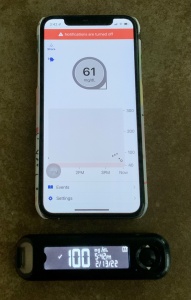 Every ten days my diabetes mental health is in jeopardy.
Every ten days my diabetes mental health is in jeopardy.
If you use insulin and diabetes tech, you probably know what happens every ten days.
Yep. I have to start a new Dexcom sensor.
The vast majority of my sensors have a horrible Day 1.
I have used CGMs for 14 years. Dexcom is aware that body chemistry affects sensor starts and that some of us struggle with Day 1. Unfortunately they don’t have a solution and have not promised improvement with G7. That being said, once I get to 18-24 hours of a sensor, my results are excellent and 95% of my sensors work well through Day 10.
Starting with Medtronic in 2008 and continuing through Dexcom 7+, G4, G5, and G6, I have a history of bad sensor starts. I’ve used arms, legs, lower abdomen, upper belly, and upper chest. I have started sensors on time. I have pre-inserted sensors for 4, 6, 12, and 24 hours. Every time I think that I have found a solution (something like make sure my BG is above 130), that solution fails with the next sensor. I am constantly frustrated with the ubiquitous Facebook advice to hydrate more. How much water can someone drink?!?
A large number of my sensors start with LOW even when my blood glucose is above 100.
 Or maybe I am lucky and get a number. I take a BG test with my meter. 94
Or maybe I am lucky and get a number. I take a BG test with my meter. 94
Of maybe the sensor starts at a number reasonably close to my meter and then quickly decides to nosedive.

I get sirens from my phone and my pump that I am low. But I am not.
Once in a while, a sensor magically starts at a good number and stays there. I don’t know why.
Then I get to the d*mned-if-I-do and d*mned-if-I-don’t issue of calibration. Many people on Facebook consider calibration to be a sin but both Tandem and Dexcom have advised me that it is okay to calibrate. The people who insist on no calibration are probably not sitting with a sensor in the 40’s that has constant Low-55 alarms from their phone and pump. If my sensor read 110 and my meter said 130, I would be okay letting that ride. But that is not my experience. I use several “rules” when I calibrate to prevent getting pushed into an endless calibration loop. I never calibrate more than 40 points at a time. I wait 15 minutes between calibrations. I try not to calibrate more than 50% of the difference between the sensor and the meter.
Sometimes a calibration or two fixes everything. Other times the sensor over-reacts to the calibration(s) and gets jumpy in a higher range or heads back down to the previous low. Sometimes the next day the sensor reads higher than the meter. But if that happens, it usually only takes one calibration to put the sensor back on track. Starting on Day 2 I am confident with almost all of my sensors and rarely use my meter through Day 10.
So why is this a mental health challenge. I understand what is happening and one would think I could just chill as I move through Day 1 of a sensor.
Number 1: I can turn off my phone for several hours to stop the 55-Low alarms. But I can’t turn off my pump and therefore can’t eliminate those alarms. Plus I want/need my phone for other activities.
Number 2: I can turn off Control IQ on my pump and manually handle my blood sugar. But when the sensor returns to a sensible number, I get suckered into turning back on Control IQ. I am stupidly optimistic about my diabetes tech and always expect it to work correctly.
Number 3: I don’t know how to fix the problem. I probably spend too much time on social media where people who have no problems blame people like me for our problems. Just because you haven’t used a meter in 4 years doesn’t mean that my Dexcom is reliable on Day 1. Calibrate or don’t calibrate? How to calibrate? Presoak my sensors or not? If so, how long? There is only so much water I can drink, so quit telling me to hydrate.
Where to from here?
At this stage I am committed to staying with Dexcom so I need to work this out. I don’t think Abbott’s Libre would be as accurate for me as Dexcom and doesn’t integrate with my pump. Senseonics’ Eversense would solve my Day 1 problems because the sensor is inserted surgically (Argh!) and lasts for 6 months. No warming up every 10 days. But Eversense doesn’t integrate with my pump and I’m not keen to face surgical implantation and extraction. After my disastrous experience with Medtronic’s Sofsensors (okay 14 years ago!), I won’t return to Medtronic without the ability to try out their current sensors and I am not enamored of their automated insulin system.
So I need to either figure out a plan to improve my Day 1 results with Dexcom or get better at coping with the Day 1 dysfunction.
My current plan is to dutifully put my sensor expiration date on my calendar and pre-insert my sensors 12-15 hours ahead of time. Interestingly my experience has been if I pre-insert 24 hours ahead, the sensor reads high on startup. And maybe that would be better than low and more easily calibrated? So I assume somewhere between no pre-insertion and 24 hours is the “magic brewing time.”
I’ll continue to start new sensors mid-morning to minimize false low alarms overnight. Frankly I don’t really have a plan to deal with the alarms from start-up LOWs and numbers in the 40’s. Maybe eat some uncovered snacks and let my BG levels rise higher than my normal targets. Something about that seems wrong….
Some of what I am dealing with is alarm fatigue, If I could turn off 55-Low alarms for a few hours on Day 1 of sensors, I could more easily deal with the inaccurate Dexcom numbers. Unfortunately the future control of unwanted alarms by the patient seems bleak. The latest Dexcom update on the Apple platform requires the acceptance of Critical Alerts and those alerts glaringly interrupt other functions on the phone for seemingly non-critical notifications. My understanding is that the release of Dexcom G7 has been delayed due to the FDA’s concern about patient notifications. Unfortunately IMO that probably means more mandatory alarms and less patient control.
I think lack of control is the biggest stressor on my diabetes mental health.
But enough ranting for now.
And please don’t tell me to drink more water.

I’ve had such a bad experience with minimed sensors, I gave up on CGM and went back to 5-6 fingersticks per day. At the time my insurance did not cover Dexcom. I can maintain A1C around 6. The Minimed training insists on calibrate once after 2 hours. then on the phone while complaining, they said try calibrate 2X with 15 minutes after the 2 hr warm up. Good Luck.
I hear you, Laddie! I had the exact same experience last week and it nearly drove me batty, as if I’m not batty enough! I try to pre-soak for at least 24 hours but this particular time I had restarted the last sensor and had to get a new one going. An engineer friend – also a diabetic – told me to calibrate 3 successive times on both pump and phone (no waiting) and it does take . . .but that doesn’t stop the roller coaster. I think this is a major issue in the life of a diabetic and something that Dexcom needs to address. As for the alarms, I have no idea how that will be remedied, if in fact it can be.
I have similar problem but mine reads too high after it warms up–like over 300 when I’m not that high. Consistently….every single sensor. I calibrate slowly to get it back to where it should be–never more than 20% at a time or I get caught in calibration loop hell. The next day, like you, it’s accurate.
I try to avoid ‘calibration’ at all costs as I usually ended up in the never-ending loop(s).
Over past few months when I’ve had serious mis-matches between my G6 and finger-stick the first thing I do is double-check my finger-stick (readings well within each other). Then I go to manual bolus on my X2 (w/Cntrl IQ on) and over-ride the G6 provided CGM reading with the current finger-stick value.
That has seemed (over a span of time) to help ‘coax’ the CGM to ‘get in line’.
On the other hand I’ve had quite good start-ups on Day One. Now and then I have a one or two off sensor start-up, but nothing even close to what you experience.
My common failure point is usually a sensor that starts to fail on Day 8 of 10. Some times I can keep it working, but most often once the arrows decide to not show up for work next to the number I’m pretty sure a new sensor will be inserted sooner than at 10-days.
I currently have 8 sensors on my shelf shipped from Dexcom due to failed sensors on Day 8 or 10 and those are from June 1, 2022. Seems like the failures tend to follow lot numbers, but my tracking is not 100% on that regard.
Hang in there Laddie … one day at a time.
Pingback: Diabetes Mental Health: Every Ten Days - My Teens Heath
You ard into alone Laddie. I end up calibrating about three times on the first dsy. I start. I like to wear those calibrations on my sleeve for everyone to see. Haters hate.
Thanks for illustrating this issue as I too have been experiencing the same challenges with the G6. 1st day always stinks no matter what I do (soak, early/late, cal/no cal, etc.). I have tried an overnight soak (just don’t start it) till morning with limited success. Just another part of the roller coaster life of a T1.
Hi Laddie, it is me again. I have been thinking about this issue of the first sensor day stinking and am trying something new. The biggest pains are the incorrect readings, calibration process and the crazy alarms because CIQ doesn’t know any better. So today I have inserted a sensor but turned off CIQ but regularly calibrating until the CGM values closely match the BG test strip readings. This eliminates all the pump alarms and gives the new sensor a chance to get on board before jacking up my BG with CIQ using false data to make corrections. It is less nerve wracking so far and I get to watch my BG and CGM values slowly converge without the anxiety and BGs ups & downs. Anyway I thought I would share this insight and hope to sleep better tonight on a new sensor. Probably turn CIQ back on tomorrow…..